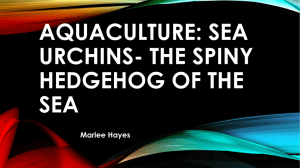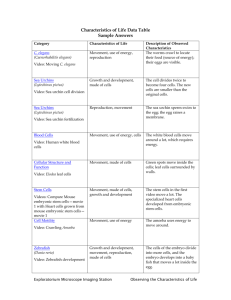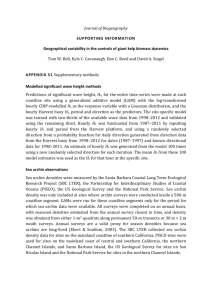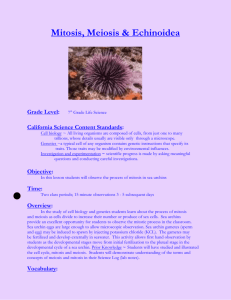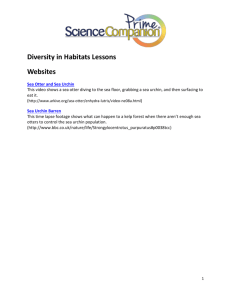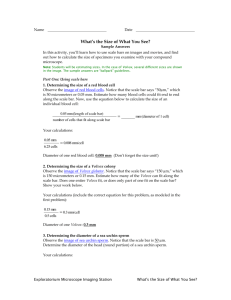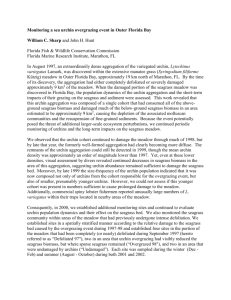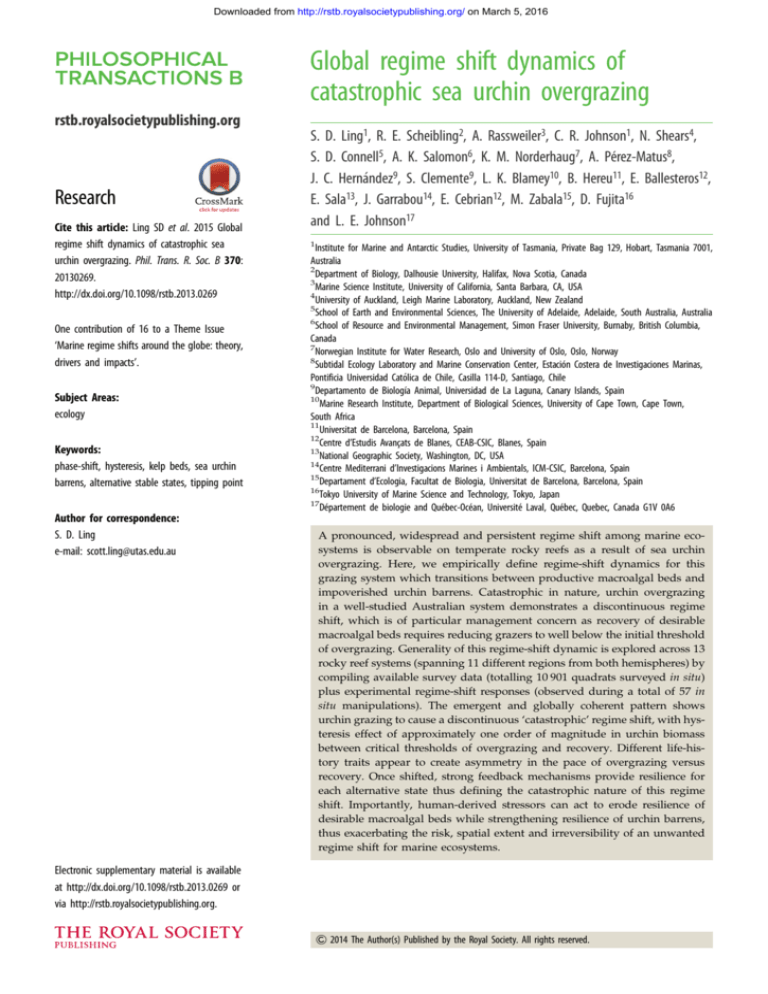
Downloaded from http://rstb.royalsocietypublishing.org/ on March 5, 2016
Global regime shift dynamics of
catastrophic sea urchin overgrazing
rstb.royalsocietypublishing.org
Research
Cite this article: Ling SD et al. 2015 Global
regime shift dynamics of catastrophic sea
urchin overgrazing. Phil. Trans. R. Soc. B 370:
20130269.
http://dx.doi.org/10.1098/rstb.2013.0269
One contribution of 16 to a Theme Issue
‘Marine regime shifts around the globe: theory,
drivers and impacts’.
Subject Areas:
ecology
Keywords:
phase-shift, hysteresis, kelp beds, sea urchin
barrens, alternative stable states, tipping point
Author for correspondence:
S. D. Ling
e-mail: scott.ling@utas.edu.au
S. D. Ling1, R. E. Scheibling2, A. Rassweiler3, C. R. Johnson1, N. Shears4,
S. D. Connell5, A. K. Salomon6, K. M. Norderhaug7, A. Pérez-Matus8,
J. C. Hernández9, S. Clemente9, L. K. Blamey10, B. Hereu11, E. Ballesteros12,
E. Sala13, J. Garrabou14, E. Cebrian12, M. Zabala15, D. Fujita16
and L. E. Johnson17
1
Institute for Marine and Antarctic Studies, University of Tasmania, Private Bag 129, Hobart, Tasmania 7001,
Australia
2
Department of Biology, Dalhousie University, Halifax, Nova Scotia, Canada
3
Marine Science Institute, University of California, Santa Barbara, CA, USA
4
University of Auckland, Leigh Marine Laboratory, Auckland, New Zealand
5
School of Earth and Environmental Sciences, The University of Adelaide, Adelaide, South Australia, Australia
6
School of Resource and Environmental Management, Simon Fraser University, Burnaby, British Columbia,
Canada
7
Norwegian Institute for Water Research, Oslo and University of Oslo, Oslo, Norway
8
Subtidal Ecology Laboratory and Marine Conservation Center, Estación Costera de Investigaciones Marinas,
Pontificia Universidad Católica de Chile, Casilla 114-D, Santiago, Chile
9
Departamento de Biologı́a Animal, Universidad de La Laguna, Canary Islands, Spain
10
Marine Research Institute, Department of Biological Sciences, University of Cape Town, Cape Town,
South Africa
11
Universitat de Barcelona, Barcelona, Spain
12
Centre d’Estudis Avançats de Blanes, CEAB-CSIC, Blanes, Spain
13
National Geographic Society, Washington, DC, USA
14
Centre Mediterrani d’Investigacions Marines i Ambientals, ICM-CSIC, Barcelona, Spain
15
Departament d’Ecologia, Facultat de Biologia, Universitat de Barcelona, Barcelona, Spain
16
Tokyo University of Marine Science and Technology, Tokyo, Japan
17
Département de biologie and Québec-Océan, Université Laval, Québec, Quebec, Canada G1V 0A6
A pronounced, widespread and persistent regime shift among marine ecosystems is observable on temperate rocky reefs as a result of sea urchin
overgrazing. Here, we empirically define regime-shift dynamics for this
grazing system which transitions between productive macroalgal beds and
impoverished urchin barrens. Catastrophic in nature, urchin overgrazing
in a well-studied Australian system demonstrates a discontinuous regime
shift, which is of particular management concern as recovery of desirable
macroalgal beds requires reducing grazers to well below the initial threshold
of overgrazing. Generality of this regime-shift dynamic is explored across 13
rocky reef systems (spanning 11 different regions from both hemispheres) by
compiling available survey data (totalling 10 901 quadrats surveyed in situ)
plus experimental regime-shift responses (observed during a total of 57 in
situ manipulations). The emergent and globally coherent pattern shows
urchin grazing to cause a discontinuous ‘catastrophic’ regime shift, with hysteresis effect of approximately one order of magnitude in urchin biomass
between critical thresholds of overgrazing and recovery. Different life-history traits appear to create asymmetry in the pace of overgrazing versus
recovery. Once shifted, strong feedback mechanisms provide resilience for
each alternative state thus defining the catastrophic nature of this regime
shift. Importantly, human-derived stressors can act to erode resilience of
desirable macroalgal beds while strengthening resilience of urchin barrens,
thus exacerbating the risk, spatial extent and irreversibility of an unwanted
regime shift for marine ecosystems.
Electronic supplementary material is available
at http://dx.doi.org/10.1098/rstb.2013.0269 or
via http://rstb.royalsocietypublishing.org.
& 2014 The Author(s) Published by the Royal Society. All rights reserved.
Downloaded from http://rstb.royalsocietypublishing.org/ on March 5, 2016
1. Introduction
(a) Frequency distributions of reef state across changing
reef conditions
To inform regime-shift dynamics between beds of canopy-forming
macroalgae and sea urchin barrens within particular reef systems,
we acquired data within the depth range of occurrence of both
reef states—i.e. from the shallow wave-determined limit of urchin
grazing on algal beds to the deep light-limited margin of these
beds, excluding reef areas heavily laden with sand. We adopted
a landscape ecology approach to determine whether reefs exist as
a vegetated, unvegetated or some mosaic between alternative
macroalgal and urchin barren states. To enable direct comparison
of systems supporting different sizes of canopy-forming seaweeds,
reef state was described by the planar percentage cover of macroalgae. While algal cover can exceed 100% for multi-layered kelp
beds, planar cover is capped at 100%. This allows comparison of
habitat-forming seaweeds of varying morphology, ranging from
laminarian kelp forests to low-lying algal canopies of the Canary
Islands and the Mediterranean (electronic supplementary material,
figure S1). Percentage cover is the most frequently reported metric
of macroalgal abundance across rocky reef systems; where it was
not measured directly conversion factors were used to generate
cover estimates from counts of individual macroalgae within quadrats. Conversions to percentage cover were performed using
(i) previously defined species-specific relationships between individual counts and percentage cover; (ii) morphometric scaling, in
Phil. Trans. R. Soc. B 370: 20130269
2. Methods
2
rstb.royalsocietypublishing.org
Widespread collapse from kelp beds to sea urchin-dominated
barren grounds provides a clear example of an unwanted
regime (or phase) shift that has played out many times for
temperate reef ecosystems worldwide [1–3]. This transition from luxuriant and productive kelp bed habitats to
impoverished and persistent barrens caused by sea urchin
overgrazing [4–8] is one of the most distinctive ecosystemlevel shifts observable for rocky subtidal seascapes (electronic
supplementary material, figure S1). The collapse of kelp beds
has been widely publicized, and much research effort has
ensued following the realized effect of destructive sea urchin
grazing and formation of urchin barren grounds over thousands of kilometres of subtidal rocky reefs worldwide, for
example in the NE Pacific in the 1960–1970s, Norwegian
coast in the 1970s, NW Atlantic in the 1970–1980s [2], and Tasmania in the 2000s where overgrazing and the threat of
widespread kelp collapse has only relatively recently emerged
[6,7,9–12].
While urchin barrens are frequently observed and processes underlying fluctuations in sea urchin populations are
well known [2,13], as for most instances of marine ecosystem
regime shift [14], the general dynamics of collapse and recovery of kelp beds remains poorly defined. Importantly, once sea
urchin grazing removes standing macroalgal biomass, the
urchin population does not collapse, but rather individual
growth rate decreases as urchins switch their feeding to less
nutritious encrusting or microalgal and invertebrate biota
growing on open rock surfaces [1,4,15,16]. Thus, once
formed, urchin barrens can be highly persistent features of
rocky reefs, lasting many decades (e.g. in Japan, the barrens
or ‘isoyake’ state has persisted for over 80 years [17]), with
individual urchins living up to 50 years on barren grounds
[16]. Therefore, the unwanted advent of sea urchin barrens
on rocky reefs is dramatic, can be spatially extensive and can
persist in the long-term across many generations of urchins.
The need to mitigate the threat of persistently degraded
reefs is exemplified in eastern Tasmania where the recent polewards range extension of the sea urchin Centrostephanus
rodgersii, driven by warming ocean climate, has led to overgrazing of kelp beds [6,7,9,10]. This new manifestation of
overgrazing has had clear negative impacts on commercial
reef-based fisheries and local biodiversity [6–8,18], motivating
the need to understand the dynamics of urchin grazing and
the resilience of kelp beds to this threat [9,19,20]. In Australia,
no other benthic herbivore has had as large a role as
C. rodgersii in determining the state of shallow reef communities [12,21], with thousands of kilometres of reef overgrazed
within the historical range of the urchin across the New
South Wales coast [22]. While widespread urchin barrens
(100 000s m2) are evident at several eastern Tasmanian reefs,
smaller ‘incipient barrens’ (10s m2) within otherwise intact
kelp beds are common and considered an early warning
sign of broader-scale kelp bed collapse along this coast [7,19].
Recent synthesis by Ling et al. [9] defined the transition
from kelp beds to C. rodgersii barrens in eastern Australia as
a nonlinear regime shift, whereby a critical threshold in sea
urchin abundance triggers overgrazing of kelp beds. This
threshold behaviour typifies the ‘sudden’ nature of collapse
documented for many ecosystems [23,24]. More importantly,
the threshold of urchin abundance triggering destructive
overgrazing of kelp beds (forward shift, F) is markedly
greater than the threshold in urchin abundance at which
kelp beds can begin to recover (reverse shift, R), demonstrating discontinuous regime-shift dynamics with hysteresis
(figure 1a). Given that some kelp beds have locally collapsed
and small incipient-barrens patches formed by C. rodgersii are
common along the eastern Tasmanian coast (figure 1b), the
widespread collapse to barrens, as in New South Wales
(figure 1c), is currently of major socioecological concern [6,7].
While significant advances have been made in understanding regime shifts driven by sea urchin grazing in Australian
[9,20] and Nova Scotian kelp-bed systems [3,25,26], the
threshold dynamics (for both forward and reverse shifts)
have not been well characterized for urchin-grazing systems
generally. Here, we ask whether available evidence indicates
a globally coherent pattern of discontinuous regime-shift
dynamics for urchin overgrazing.
To explore global dynamics, we compile available empirical data for a wide range of rocky reef systems prone to high
sea urchin abundances and overgrazing impacts. Importantly, while sea urchin grazing can occur at broad coastal
scales, it is interactions between grazing sea urchins and
their macroalgal food at local scales (100 – 101 m2) that leads
to the emergent and widespread collapse of standing algal
beds [26–28]. Thus, to understand regime-shift dynamics at
this scale, for each discrete rocky reef system, we examine
(i) frequency distributions of reef state (i.e. percentage macroalgal cover) across a range of reef conditions (i.e. urchin
biomass) where both macroalgal cover and sea urchin abundance has been co-recorded in situ in the same quadrat
spaces, and (ii) responses of macroalgal beds to natural or
manipulated changes in urchin abundance. Finally, we examine the existence of state-dependent feedbacks and stressors
implicated in triggering and maintaining regime shifts
between macroalgal beds and urchin barrens.
Downloaded from http://rstb.royalsocietypublishing.org/ on March 5, 2016
(a)
3
100
rstb.royalsocietypublishing.org
kelp bed cover (%)
80
60
F
reverse shift
40
forward shift
20
R
0
Phil. Trans. R. Soc. B 370: 20130269
(b) Eastern Tasmania
kelp bed
kelp bed cover (%)
100
80
60
40
20
sea urchin barren
0
(c) NSW
kelp bed
kelp bed cover (%)
100
80
60
40
20
sea urchin barren
0
0
1
2
6
7
8
3
4
5
sea urchin abundance (individ. m–2)
9
10
Figure 1. Catastrophic regime shift between kelp beds and sea urchin barrens. (a) Conceptual schematic of catastrophic ‘discontinuous’ regime-shift dynamic
(redrawn from Ling et al. [9], after Scheffer et al. [24]). If the reef system occurs in the kelp state on the upper path (red) but close to the threshold F, a
slight increase in sea urchin density may induce a catastrophic forward shift to the alternative and stable sea urchin barrens state. Once barrens have formed,
reverting back to the kelp state is difficult, because the system demonstrates hysteresis, and the reverse shift (blue path) occurs only if sea urchin density is reduced
below the return threshold at R. The broken grey line indicates an unstable equilibrium between the alternative stable states. (b,c) Scatter plots of kelp bed cover
(%) across a range of sea urchin density (individuals m22) for (b) recently established Centrostephanus rodgersii in eastern Tasmania (n ¼ 5135; 5 1 m quadrats
sampled in 2001– 2002 and 2008) and (c) historical range of grazing impacts in New South Wales (NSW; n ¼ 129, 5 1 m quadrats sampled in 2004– 2006).
Scatter plots are defined by semi-transparent bubbles, where increasing bubble size indicates increasing frequency of particular combinations of urchin density and
macroalgal cover: darker shading indicates increased overlap between neighbouring bubbles. Overlaid arrows indicate magnitude and direction of ecosystem response
to removals and additions of C. rodgersii in respective systems (after electronic supplementary material, table S2).
which average planar canopy area of individual adult stages was
determined (see electronic supplementary material, table S1).
Rocky reef ‘condition’ was defined as sea urchin biomass (wet
weight, g m22) because numerical density alone does not allow
standardization across reef systems supporting urchins of different
individual size and mass. Even within species, density-dependent
processes can result in areas of few large or many small sea urchins, with similar biomass per unit area [16]. Because sea urchin
biomass was rarely measured directly within individual quadrats,
it was estimated using two approaches: (i) where test diameter
(TD) was recorded for individuals, wet weight was estimated by
allometric conversion and summed across individuals in a quadrat (electronic supplementary material, table S1), and (ii) where
individual TD was not recorded, mean wet weight per individual
sea urchin was estimated from species-specific allometric conversion of the average TD from a sample of the population, which
was then multiplied by the total count of sea urchins in a quadrat
(electronic supplementary material, table S1).
Downloaded from http://rstb.royalsocietypublishing.org/ on March 5, 2016
(b) Responses of reef state to altered reef conditions
4. Discussion
(a) A globally coherent discontinuous regime shift
3. Results
Observed frequency distributions of macroalgal cover across
sea urchin biomass were compiled for 13 globally representative rocky reef systems that are known to occur as algal bed
or urchin barrens states (see map, electronic supplementary
material, figure S2). Across reef systems, survey data showed
clear separation of these alternative reef states and an abrupt
collapse of macroalgal habitat to urchin barrens at high
urchin biomass (figure 2a–m). Urchin barrens are maintained
across a large range of urchin biomass and can occur at
levels of urchin biomass less than those observed on macroalgal-dominated reefs. Observed magnitudes and directions of
change within particular systems are indicative of hysteresis,
as barrens formation (forward shift) typically occurs at much
higher levels of urchin biomass than that for which macroalgal
recovery (reverse shift) is observed to occur (cf. red and blue
arrows, figure 2).
Pooling correlative data for all systems globally, the
observed ceiling of macroalgal cover against increasing sea
urchin biomass is consistent with expectations of a nonlinear
threshold defining urchin barrens formation (cf. figures 1a
and 3a). Compilation of a total of 57 observed regime-shift
responses from rocky reefs studies worldwide (electronic
supplementary material, table S2) shows that urchin barrens
are created under conditions of moderate to high sea urchin
biomass (red ‘forward shift’ arrows compiled from 17
observed shifts; figure 3b), whereas recovery of macroalgal
habitat, once sea urchin barrens have formed, generally
occurs at much lower levels of urchin biomass (blue ‘reverse
shift’ arrows compiled from 40 observed shifts; figure 3b).
Considering all studies reporting urchin barrens formation,
the mean (+s.e.) urchin biomass for which macroalgal habitats are collapsed by overgrazing is 2640 + 824 g m22
(electronic supplementary material, table S2). Excluding
high urchin biomass (more than 1500 g m22; figure 3b,c), a
mean urchin biomass of 668 (+115 g m22) can be considered
to represent the minimum threshold for which overgrazing is
observed for rocky reef systems globally (electronic supplementary material, table S2).
The frequency of observed forward-shift (urchin barrens
formation) events shows a distinctly different distribution
across the range of sea urchin biomass (right skewed red
Our global compilation of empirical patterns across rocky reef
systems prone to urchin grazing is consistent with expectations
of discontinuous ‘catastrophic’ regime-shift dynamics. Results
show that sea urchins become incapable of maintaining sea
urchin barrens at a biomass below approximately 70 g m22,
whereas the biomass of sea urchins required to form barrens
in the first instance is approximately 700 g m22. Thus, by
definition, the hysteresis evident for this regime shift is
approximately one order of magnitude of sea urchin biomass.
Simply put, the available empirical evidence for rocky reef systems worldwide reveals that the abundance of sea urchins
required to form barrens is greater than that required to maintain a barren and that recovery of productive macroalgal beds
requires virtually all urchins to be removed.
Notably, while macroalgal bed recovery occurs consistently when urchins are absent or at low biomass, overgrazing
of macroalgal beds occurs over a much wider range of
urchin biomass (figure 3b,c). This probably reflects the more
heterogeneous structure of kelp bed habitats across the globe
and passive versus active modes of urchin grazing which
occur within macroalgal beds [29] relative to the homogeneous
barrens state, which shows much greater structural consistency
(see electronic supplementary material, figure S1) and is
maintained by a more consistent biomass and grazing behaviour of urchins (figure 3b,c). In addition, while the catastrophic
regime-shift dynamic appears generally applicable across
urchin-grazing systems, there is a dearth of information on
forward and reverse shift dynamics within particular rocky
reef systems (figure 2 and electronic supplementary material,
table S2). Thus, while general dynamics and threshold
values are reported here, further experimental manipulations
and modelling studies [20] are clearly warranted to quantify
dynamics and identify thresholds and options for reef
management within particular urchin-grazing systems.
While sea urchin grazing dynamics are evidently catastrophic in nature, with macroalgal beds and urchin barrens
representing the alternative stable states of rocky reef ecosystems (see also [3]), there is high variability across different
urchin-grazing systems, particularly with respect to the
range of urchin biomass and the degree of transitory
dynamics in macroalgal cover (figure 2). Therefore, further
exploration of the rates of macroalgal primary production,
urchin grazing, and predation on sea urchins is warranted
4
Phil. Trans. R. Soc. B 370: 20130269
distribution; figure 3c) compared with that of reverse-shift
(macroalgal recovery) events (left skewed blue distribution;
figure 3c). In contrast to the threshold for barrens formation,
the mean threshold biomass of sea urchins that allows for
macroalgal recovery is 34 + 11 g m22 (electronic supplementary material, table S2). While it is clear that a complete
absence of sea urchins will enable kelp beds to recover, by
excluding studies reporting macroalgal recovery at zero
urchin biomass, the mean urchin biomass threshold allowing
macroalgal recovery is estimated at 71 + 20 g m22 (electronic
supplementary material, table S2). Upon reaching critical
regime-shift thresholds, the mean (+s.e.) time observed for
barrens formation and macroalgal recovery was 6.35 + 1.2
and 18.5 + 2.0 months, respectively (electronic supplementary
material, table S2).
rstb.royalsocietypublishing.org
Defining the envelope of possible combinations between reef state
(macroalgal cover) and reef conditions (urchin biomass), the
frequency distribution approach above provides an instantaneous
snapshot of possible relationships from which alternative reef
states may be inferred. Overlaying such distributions with
observed shifts in reef state, in both magnitude and direction, to
changes in ‘reef conditions’ informs the nature of regime-shift
dynamics. Responses in macroalgal cover observed following
natural or manipulated changes in sea urchin abundance were
compiled by sourcing data from published and unpublished
experimental and observational field studies. These studies documented macroalgal cover and sea urchin abundance both before
and after a regime shift occurred. Where neither macroalgal
cover nor sea urchin biomass was measured directly, conversions
were performed as per the generation of frequency distributions
described above. The frequency distributions of sea urchin biomass resulting in forward and reverse shifts were compared
statistically using the non-parametric Kolmogorov–Smirnoff test
and means were compared using 1-way ANOVA.
Downloaded from http://rstb.royalsocietypublishing.org/ on March 5, 2016
(a)
(b)
(c)
Nova Scotia, n = 115
Gulf St. Lawrence, n = 157
(d)
Canary Is., n = 800
Northern Hemisphere
100
80
60
40
20
0
0
3500
8500
13 500
0
(f)
California, n = 677
500 1000 1500 2000
0 2000
(g)
Norway, n = 1025
5000
8000
0
(h)
Japan, n = 262
250 500 750 1000
Mediterranean, n = 578
100
80
60
40
20
0
0 500 1500 2500 3500
(i)
Australia, Centrostephanus, n = 5264
0 500
( j)
1500
2500
3500
0 500
1500
2500
0
250 500 750 1000
New Zealand, n = 642
100
80
60
40
20
0
0
(k)
750
1750
0
2750
Australia, Heliocidaris, n = 628
(l)
3500
8500
13 500
(m)
Chile, n = 332
South Africa, n = 260
100
80
60
40
20
0
0 1500 3500 5500 7500
0
1500
3500
0
1250
3250
sea urchin biomass (g m–2)
Figure 2. Regime-shift dynamics between macroalgal beds and sea urchin-dominated barrens on 13 rocky reef systems worldwide. (a– h) Northern Hemisphere and
(i – m) Southern Hemisphere; n, no. quadrat samples (after electronic supplementary material, table S1; see also world map in the electronic supplementary
material, figure S2). As per figure 1, semi-transparent bubbles represent relative frequency of particular combinations of urchin biomass (g m22) and macroalgal
cover (%). Where available for particular regions, overlaid arrows show the direction and magnitude of regime shifts (forward shift, red arrows; reverse shift, blue
arrows) observed following natural and manipulated change in sea urchin biomass (after electronic supplementary material, table S2). Note that x-axes vary in scale
across regions.
to identify processes operating across systems that result in
either a build-up of urchin biomass towards a forward-shift
threshold, or a decline in biomass to below a reverse-shift
threshold, that determine the dynamics of regime shift [30].
For example, although urchin populations can reach high biomass in South Africa and the general dynamic of overgrazing
applies across this productive kelp system (figure 2j ), urchindominated patches are observed to remain as highly localized
features (100 –101 m) devoid of the negative ecological
impacts reported for extensive urchin barrens elsewhere [31].
(b) Time asymmetry in discontinuous dynamics?
Once critical tipping points in sea urchin biomass are
reached, barrens formation occurs in one third of the time
(forward shift approx. six months) that is required for recovery of kelp bed habitats (reverse-shift approx. 18 months;
electronic supplementary material, table S2). But while overgrazing of kelp beds is a relatively abrupt event, many years
may be required for urchin populations to build towards this
critical biomass threshold. For example, the sea urchin C. rodgersii has a planktotrophic larvae that develops over three
months (see [10]) before settling to the reef, after which
another 5–7 years elapse before the urchins emerge from
crypsis to graze macroalgae on the reef surface [10,12,16].
Furthermore, in situations where sea urchins from adjacent
deep-living populations aggregate at the lower margin of
kelp beds (e.g. Strongylocentrotus droebachiensis in the NW
Atlantic), typically it is the larger size-classes that dominate
urchin biomass at mobile grazing ‘fronts’ [28]. So while the
time taken for overgrazing may be relatively sudden, the
time necessary to build urchin populations towards a critical
threshold in abundance can be protracted.
In contrast, providing urchin grazing pressure is sufficiently
relaxed and connectivity to local spore sources exists, macroalgal life-history strategies enable a more immediate local
response in recruitment and growth through to mature stands
within the estimated approximately 18 months required for
the system-wide reverse shift (see electronic supplementary
material, table S2). The age structure of populations of C. rodgersii across eastern Tasmania [10] provides evidence of gradual
building towards a critical transition in the rate of herbivory,
as urchin populations approach the average age (approx. 20
years old) at which overgrazing occurs [12,20]. This protracted
onset is evident in comparing size–frequency distributions of
populations in Tasmania with those in New South Wales,
Phil. Trans. R. Soc. B 370: 20130269
macroalgal bed cover (%)
(e)
5
rstb.royalsocietypublishing.org
Southern Hemisphere
British Columbia, n = 161
Downloaded from http://rstb.royalsocietypublishing.org/ on March 5, 2016
(a)
6
100
rstb.royalsocietypublishing.org
75
25
0
0
500
1000
1500 2000
6000
10 000
14 000
0
500
1000
1500 2000
6000
10 000
14 000
100
75
50
25
0
(c)
reverse shift
forward shift
frequency of observed shift
25
15
20
10
15
10
5
5
0
1500
>
1400
1300
1200
1100
1000
900
800
700
600
500
400
300
200
0
100
0
sea urchin biomass (g m–2)
Figure 3. Global regime-shift dynamics between cover of macroalgal beds and sea urchin barrens across increasing urchin biomass. (a) Macroalgal bed cover versus sea urchin
biomass; presented as a scatter plot with intensity of shading representing frequency of particular macroalgal cover/urchin biomass combinations for all available rocky reef
quadrats (n ¼ 10 151) sourced from 13 regions globally (after electronic supplementary material, table S1). (b) Observed direction and magnitude of shifts in macroalgal cover
versus sea urchin biomass; red arrows indicate forward shift from macroalgal beds to urchin barrens; blue arrows indicate reverse shift recovery from urchin barrens back to
healthy macroalgal beds, n ¼ 57 observations globally (after electronic supplementary material, table S2); (c) frequency histogram of studies observing forward (red, n ¼ 17)
and reverse (blue, n ¼ 40) regime shifts across increasing sea urchin biomass; frequency distributions were significantly different (Kolmogorov–Smirnov test; D ¼ 0.95, p ,
0.0001), as were means (1-way ANOVA, stabilizing transformation ¼ urchin biomass0.2, F1,55 ¼ 100.4, p , 0.0001). Note that to effectively display the full range of urchin
biomass in (a,b), x-axis tick marks increase by units of 500 until axis break, with units of 4000 thereafter.
where long-established urchin populations appear to have
driven down kelp abundance to a greater extent. It suggests
that the time required for urchin populations to build to
threshold levels for overgrazing, in addition to the time
course of transition from kelp to barrens itself, is much longer
than commonly perceived (see ‘Living on borrowed-time concept’ [32]). Once a trajectory of rapid population growth and
accumulation of urchin biomass on rocky reefs is initiated, overgrazing is likely to ensue unless urchin abundance is somehow
held below the threshold for barrens formation. Thus, the current
state of the ecosystem and its resilience to external stressors,
including influx of settling urchins, are key determinants of the
likelihood of regime shift.
(c) Reinforcing feedbacks and stressors eroding
resilience
Rocky reef systems are influenced by myriad complex interactions between physical and biological processes acting
across a wide spectrum of spatial and temporal scales (reviewed
by [2,3,11]). For systems that exhibit discontinuous ‘catastrophic’ regime-shift dynamics between alternative states,
understanding the self-maintaining positive-feedback mechanisms that confer resilience (i.e. persistence stability [33]) of a state
to external stressors is critically important [9,20]. Various positive feedback mechanisms maintain the stability of macroalgal
and urchin barrens states (table 1a; see also [3]), and the stressors
Phil. Trans. R. Soc. B 370: 20130269
(b)
macroalgal bed cover (%)
50
Downloaded from http://rstb.royalsocietypublishing.org/ on March 5, 2016
(b) state-dependent stressors decreasing resilience
macroalgal beds
reference
presence of functional urchin predators
—macro-predators
—micro-predators
macroalgal beds to urchin barrens
*overharvesting of urchin predators
[4,9,34–36,38]
[4,9,34–38]
[39]
multi-trophic consequences of prey-switching
by natural predators
[62]
*presence of human urchin harvest/urchin culling
[40]
(*)presence of urchin disease
[28]
high macroalgal productivity
—local standing macroalgae
—distant allocthonous inputs
[29]
[41,42]
large macroalgal bed biomass (patch-size dynamics)
[16,19,43]
propagule supply (connectivity)
[4,44]
natural barriers to urchin movement
—high swell/ current exposure
—macroalgal whiplash
[45]
[16,46]
urchin barrens
reference
diet switching from large macroalgae to
encrusting/ filamentous forms
[4]
*continued harvesting of urchin predators
[35,47]
increased urchin foraging rates causing high
mortality of juvenile kelp
[4,48–51]
reduced urchin dislodgement due to absence
of kelp whiplash
increased urchin recruitment in absence
of macroalgae
reduced predation in absence of kelp:
—increased spine length
—decreased palatability for human harvest
and/or natural predators
facilitation of juvenile survival by adults:
—reducing micro-predator abundance by
eliminating macroalgae
—offering refugia under adult urchin spine canopy
increasing barren size (patch-size dynamic)
reduced macroalgal propagule supply
increased abundance of mesograzing invertebrates
*kelp disease/overgrowth by inva sive algae/epiphytes
*direct removal of kelp
[28,61]
—human harvest
[63]
(*)acute physical change
—storms/ extreme weather
—warm periods promoting sea urchin larval survival
—cool periods promoting sea urchin recruitment
[63]
[64]
[65]
(*)chronic physical change
—declining algal productivity due change in
oceanography/ catchment processes
—declining algal productivity of allochthonous
macroalgal ‘drift’ supply
—range-extension of urchins
other mesograzers
[10,16,52,53]
[16]
[16,52,54,55]
[63,66]
[67]
[10,68]
[60,69]
urchin barrens to macroalgal beds
reference
presence of functional urchin predators
[9,34–36,38,70,71]
*human urchin harvest/urchin culling
(*)increasing macroalgal productivity due to
[40,72]
strengthening wave conditions
urchin disease
[16,46]
reference
[48,73]
[74,75]
(*)acute physical change
—hurricane events leading to increased urchin disease [76]
[77]
—freshwater flood events
(*)chronic physical change
—increasing temperature increasing urchin disease
—increasing temperature reducing urchin settlement
— increasing temperature causing range-extension of
urchin predators
[78]
[79]
[80]
[39]
[56–59]
[43]
[44]
[60]
*local presence of invasive algae/ ephemeral algae
and epiphytes restricting kelp re-growth
[61]
capable of eroding resilience are also state-dependent (table 1b).
While state-dependent stressors can be identified separately,
they rarely act in isolation. Therefore, predicting interactions
among multiple stressors, including anthropogenic climate
change [81] and overfishing [9,18], is fundamental for managing
systems prone to catastrophic regime-shift dynamics (table 1).
The ability of sea urchin predators to control sea urchin
abundance, and to effect trophic cascades, underscores the
importance of state-dependent feedbacks and hysteresis in
the urchin-grazing system (table 1). That is, hysteresis in this
system means that approximately one order of magnitude
more urchin biomass must be consumed by predators to
revert barrens to macroalgal beds compared with that required
to maintain the macroalgal-dominated state by keeping urchin
density just below the critical forward-shift threshold. Furthermore, this hysteresis is compounded as urchins are less
vulnerable to predation when occurring on barrens owing to
longer protective spines, a greater abundance of individuals
for a given biomass, decreased palatability and an overall
reduction in predator abundance on rocky reefs in the absence
of macroalgal habitat (table 1). Thus, while the role of predators in controlling the abundance of sea urchins features
extensively in the literature [2,13], this pivotal hysteresis
has not been considered. Our global synthesis indicates that
Phil. Trans. R. Soc. B 370: 20130269
(a) state-dependent feedbacks reinforcing resilience
7
rstb.royalsocietypublishing.org
Table 1. Feedbacks and stressors of alternative macroalgal-dominated and urchin barren rocky reef states. (a) State-dependent mechanisms creating positive
feedbacks reinforcing resilience of each alternative reef state (see also review by Filbee-Dexter & Scheibling [3]). (b) State-dependent processes that erode
resilience of each alternative reef state. Panels shaded in blue indicate feedbacks and processes favouring maintenance and recovery of desirable macroalgal
beds; red shading indicates unfavourable regime shift and maintenance of the unwanted urchin barrens state. Note that human-derived stressors are indicated
by asterisks and that multiple stressors, both human-derived and natural processes, may interact to either maintain or erode resilience in additive, synergistic or
antagonistic manners (e.g. asterisks within parentheses indicate physical processes influenced by anthropogenic-forcing on global climate).
Downloaded from http://rstb.royalsocietypublishing.org/ on March 5, 2016
Globally, the occurrence of urchin barrens on rocky reef represents an unwanted regime shift from the desirable kelp
bed state, which proves difficult to reverse. Hence, onus
must be squarely placed on understanding when this type of
system is approaching its tipping point, so that collapse of
desirable ecosystem states may be avoided. For ecosystems
displaying such discontinuous ‘catastrophic’ regime-shift
dynamics, increasing resilience of desirable ecosystem states
before a shift occurs will be much more effective than attempts
to break resilience of unwanted ecosystem states once the
system has moved to a new self-reinforcing regime (table 1).
That is, the herein defined globally coherent catastrophic
regime shift supports a general rule that small amounts of
prevention will be far more effective than large amounts of
Data accessibility. Summarized information is available as the electronic
supplementary material. Full raw data are available on request from
Scott Ling (scott.ling@utas.edu.au).
Funding statement. S.D.L. was supported by an Academic Career Development Scholarship, University of Tasmania. Field sampling was
supported by the Fisheries Research Development Corporation &
Department of Sustainability & Environment (Victoria) to C.R.J.;
Australian Research Council funds & Future Fellowship to S.D.C.;
Natural Sciences & Engineering Research Council of Canada
(NSERC) Discovery Grant to R.E.S.; Santa Barbara Coastal LTER
(S. Harrer); New Zealand Department of Conservation to N.S.;
NSERC, Parks Canada, Department of Fisheries & Oceans Canada
(DFO) and Tula Foundation grants to A.K.S.; The Fram Centre, The
Norwegian Environment Agency & Norwegian Research Council
grants to Hartvig Christie & Eli Rinde; FONDECYT National Fund
for Scientific & Technological Development to A.P.; Ministerio de
Ciencia e Innovación & CEI-Canarias, Campus Atlántico Tricontinental & Ministerio de Educación to J.H. and S.C.; The University of
Cape Town & the National Research Foundation to L.K.B.,
K. Reaugh and J Jackelman.
References
1.
2.
3.
4.
5.
6.
7.
Lawrence JM. 1975 On the relationships between
marine plants and sea urchins. Oceanogr. Mar. Biol.
Annu. Rev. 13, 213–286.
Steneck RS, Graham MH, Bourque BJ, Corbett D,
Erlandson JM, Estes A, Tegner MJ. 2002 Kelp forest
ecosystems: biodiversity, stability, resilience and
future. Environ. Conserv. 29, 436 –459. (doi:10.
1017/S0376892902000322)
Filbee-Dexter K, Scheibling RE. 2014 Sea urchin
barrens as alternative stable states of collapsed kelp
ecosystems. Mar. Ecol. Prog. Ser. 495, 1–25.
(doi:10.3354/meps10573)
Chapman ARO. 1981 Stability of sea urchin dominated
barren grounds following destructive grazing of kelp in
St. Margaret’s Bay, Eastern Canada. Mar. Biol. 62,
307–311. (doi:10.1007/BF00397697)
Andrew NL, Underwood AJ. 1992 Associations and
abundance of sea urchins and abalone on shallow
subtidal reefs in southern New South Wales.
Aust. J. Mar. Freshw. Res. 43, 1547 –1559. (doi:10.
1071/MF9921547)
Johnson CR et al. 2011 Climate change cascades:
shifts in oceanography, species’ ranges and subtidal
marine community dynamics in eastern Tasmania.
J. Exp. Mar. Biol. Ecol. 400, 17 –32. (doi:10.1016/j.
jembe.2011.02.032)
Johnson CR, Ling SD, Ross J, Shepherd S, Miller K.
2005 Establishment of the long-spined sea urchin
(Centrostephanus rodgersii) in Tasmania: first
assessment of potential threats to fisheries.
Fisheries Research and Development
Corporation Final Report, Project No. 2001/044,
8.
9.
10.
11.
12.
13.
University of Tasmania, Hobart, Tasmania,
Australia.
Ling SD. 2008 Range expansion of a habitat-modifying
species leads to loss of taxonomic diversity: a new and
impoverished reef state. Oecologia 156, 883–894.
(doi:10.1007/s00442-008-1043-9)
Ling SD, Johnson CR, Frusher S, Ridgway K. 2009
Overfishing reduces resilience of kelp beds to
climate-driven catastrophic phase shift. Proc. Natl
Acad. Sci. USA 106, 22 341–22 345. (doi:10.1073/
pnas.0907529106)
Ling SD, Johnson CR, Ridgway K, Hobday A, Haddon
M. 2009 Climate-driven range extension of a sea
urchin: inferring future trends by analysis of recent
population dynamics. Glob. Change Biol. 15,
719 –731. (doi:10.1111/j.1365-2486.2008.01734.x)
Steneck RS, Johnson CR. 2014 Kelp forests: dynamic
patterns, processes, and feedbacks. In Marine
community ecology and conservation (eds
M Bertness, J Bruno, B Silliman, J Stachowicz),
pp 315–336. Sunderland, MA: Sinauer Associates.
Ling SD. 2013 Pushing boundaries of range and
resilience: a review of range-extension by a barrensforming sea urchin. In Climate change perspectives
from the Atlantic: past, present and future
(eds JM Fernández-Palacios, L De Nascimiento,
JC Hernández, S Clemente, A González,
JP Diaz-González) Tenerife, Canary Islands: Servicio
de Publicaciones de la Universidad de La Laguna.
Estes JA et al. 2011 Trophic downgrading of planet
earth. Science 333, 301– 306. (doi:10.1126/science.
1205106)
14. Conversi A et al. 2015 A holistic view of marine
regime shifts. Phil. Trans. R. Soc. B 370, 20130279.
(doi:10.1098/rstb.2013.0279)
15. Johnson CR, Mann KH. 1982 Adaptations of
Stronglyocentrotus droebachiensis for survival
on barren grounds in Nova Scotia. In Echinoderms:
Proc. Int. Conf., Tampa Bay (ed. JM Lawerence),
pp. 277–283. Rotterdam, The Netherlands:
Balkema.
16. Ling S, Johnson C. 2009 Population dynamics of an
ecologically important range-extender: kelp beds
versus sea urchin barrens. Mar. Ecol. Prog. Ser. 374,
113–125. (doi:10.3354/meps07729)
17. Watanuki A, Aota T, Otsuka E, Kawai T, Iwahashi Y,
Kuwahara H, Fujita D. 2010 Restoration of kelp beds
on an urchin barren: removal of sea urchins by
citizen divers in southwestern Hokkaido. Bull. Fish.
Res. Agen. 32, 83 –87.
18. Rocha J, Yletyinen J, Biggs R, Blenckner T, Peterson
G. 2015 Marine regime shifts: drivers and
impacts on ecosystems services. Phil. Trans. R.
Soc. B 370, 20130273. (doi:10.1098/rstb.2013.0273)
19. Flukes E, Johnson C, Ling S. 2012 Forming sea
urchin barrens from the inside out: an alternative
pattern of overgrazing. Mar. Ecol. Prog. Ser. 464,
179–194. (doi:10.3354/meps09881)
20. Marzloff MP et al. 2013 Sensitivity analysis and
pattern-oriented validation of TRITON, a model
with alternative community states: insights
on temperate rocky reefs dynamics. Ecol.
Model. 258, 16 –32. (doi:10.1016/j.ecolmodel.2013.
02.022)
8
Phil. Trans. R. Soc. B 370: 20130269
5. Conclusion
cure for collapsed ecosystems. Defining such regime-shift
dynamics and the potential state-dependent feedback mechanisms at play is therefore crucial for any attempt to manage
this type of system for maximum social and ecological benefit
[83]. Such practical understandings are urgent in an era of
increasing human-derived stressors, many of which interact
(table 1) to accelerate the frequency, extent and irreversibility
of ecosystem change from local to global scales.
rstb.royalsocietypublishing.org
management of urchin grazing, including attempts to remedy
urchin grazing by facilitating recovery of urchin predators,
must be squarely underpinned by this hysteresis effect. Implementing such management can be achieved by employing
a ‘resilience-based approach’ focused not only on building
resilience of the desirable macroalgal bed state, but also committing to the more difficult task of eroding resilience of the
unwanted urchin barrens state once it has formed (table 1;
see also [82,83]).
Downloaded from http://rstb.royalsocietypublishing.org/ on March 5, 2016
53. Hernández JC et al. 2010 Effect of temperature on
settlement and postsettlement survival in a barrensforming sea urchin. Mar. Ecol. Prog. Ser. 413.
54. Byrne M et al. 1998 Reproduction in the
diadematoid sea urchin Centrostephanus rodgersii
in contrasting habitats along the coast of
New South Wales, Australia. Marine Biology 132,
305–318.
55. Eurich J, Selden R, Warner R. 2014 California spiny
lobster preference for urchins from kelp forests:
implications for urchin barren persistence. Mar. Ecol.
Prog. Ser. 498, 217–225.
56. Tegner MJ, Dayton PK. 1976 Sea urchin recruitment
patterns and implications of commerical fishing.
Science, pp. 324–326.
57. Tegner MJ, Dayton PK. 1981 Population structure,
recruitment and mortality of two sea urchins
(Stronglyocentrotus franciscanus and S. purpuratus)
in a kelp forest. Mar. Ecol. Prog. Ser. 5,
255–268.
58. Zhang Z et al. 2011 Recruitment patterns and
juvenile –adult associations of red sea urchins in
three areas of British Columbia. Fisheries Research
109, 276–284.
59. Hereu B et al. 2012 Multiple processes regulate
long-term population dynamics of sea
urchins on Mediterranean rocky reefs. PLoS ONE
7, e36901.
60. Fletcher WJ. 1987 Interactions among subtidal
Australian sea urchins, gastropods, and algae:
effects of experimental removals. Ecol. Monograph.
57, 89 – 109.
61. Kelly JR, Scheibling RE, Balch T. 2011 Invasionmediated shifts in the macrobenthic assemblage of
a rocky subtidal ecosystem. Mar. Ecol. Prog. Ser.
437, 69– 78.
62. Estes JA et al. 1998 Killer whale predation on sea
otters linking oceanic and nearshore ecosystems.
Science 282, 473–476.
63. Dayton PK et al. 1998 Sliding baselines, ghosts, and
reduced expectations in kelp forest communities.
Ecol. Appl. 8, 309–322.
64. Hart MW, Scheibling RE. 1988 Heat waves, baby
booms, and the destruction of kelp beds by sea
urchins. Marine Biology 99, 167 –176.
65. Sivertsen K. 2007 Overgrazing of kelp beds along
the coast of Norway. In Eighteenth International
Seaweed Symposium. Springer.
66. Tegner MJ et al. 1995 Sea urchin cavitation of giant
kelp (Macrocystis pyriferaC. Agardh) holdfasts and
its effects on kelp mortality across a large California
forest. Journal of Experimental Marine Biology and
Ecology 191, 83 –99.
67. Harrold C, Reed DC. 1985 Food availability, sea
urchin grazing and kelp forest community structure.
Ecology 66, 1160– 1169.
68. Ling S et al. 2008 Reproductive potential of a
marine ecosystem engineer at the edge of a
newly expanded range. Global Change Biology 14,
907–915.
69. Johnson CR, Mann KH. 1986 The importance of
plant defence abilities to the structure of subtidal
seaweed communities: The kelp Laminaria
9
Phil. Trans. R. Soc. B 370: 20130269
37. Clemente S et al. 2010 Identifying keystone
predators and the importance of preserving
functional diversity in sublittoral rocky-bottom
areas. Mar. Ecol. Prog. Ser. 413, 55 –67.
38. Ling S, Johnson C. 2012 Marine reserves reduce risk
of climate-driven phase shift by reinstating sizeand habitat-specific trophic interactions. Ecol. Appl.
22, 1232–1245.
39. Bonaviri C et al. 2012 Micropredation on sea urchins
as a potential stabilizing process for rocky reefs.
Journal of Sea Research 73, 18 –23.
40. Steneck RS. 1997 Fisheries-induced biological
changes to the structure and function of the Gulf of
Maine ecosystem. In Proceedings of the Gulf of
Maine ecosystem dynamics scientific symposium and
workshop. Regional Association for Research on the
Gulf of Maine Hanover, NH.
41. Britton-Simmons KH, Foley G, Okamoto D. 2009
Spatial subsidy in the subtidal zone: utilization of
drift algae by a deep subtidal sea urchin. Aquat.
Biol. 5, 233– 243.
42. Kelly JR, Krumhansl KA, Scheibling RE. 2012
Drift algal subsidies to sea urchins in lowproductivity habitats. Mar. Ecol. Prog. Ser. 452,
145 –157.
43. Connell SD, Irving AD. 2008 Integrating ecology with
biogeography using landscape characteristics: a case
study of subtidal habitat across continental Australia.
Journal of Biogeography 35, 1608–1621.
44. Keats D, South G, Steele D. 1990 The effects of an
experimental reduction in grazing by green sea
urchins on a benthic macroalgal community in
eastern Newfoundland. Mar. Ecol. Prog. Ser. 68,
181 –193.
45. Kawamata S. 2010 Inhibitory effects of wave action
on destructive grazing by sea urchins: a review.
Bulletin of Fisheries Research Agency 32, 95 –102.
46. Konar B. 2000 Seasonal inhibitory effects of marine
plants on sea urchins: structuring communities the
algal way. Oecologia 125, 208–217.
47. Clemente S, Hernández J, Brito A. 2011 Contextdependent effects of marine protected areas on
predatory interactions. Mar. Ecol. Prog. Ser. 437,
119 –133.
48. Lauzon-Guay J-S, Scheibling RE. 2007 Seasonal
variation in movement, aggregation and destructive
grazing of the green sea urchin (Strongylocentrotus
droebachiensis) in relation to wave action and sea
temperature. Marine Biology 151, 2109–2118.
49. Jones N, Kain J. 1967 Subtidal algal colonization
following the removal of Echinus. Helgoländ Wiss
Meer 15, 460–466.
50. Gagnon P, Himmelman J, Johnson L. 2014 Temporal
variation in community interfaces: kelp-bed
boundary dynamics adjacent to persistent urchin
barrens. Marine Biology 144, 1191–1203.
51. Dumont CP, Himmelman JH, Russell MP. 2006 Daily
movement of the sea urchin Strongylocentrotus
droebachienis in different subtidal habitats in
eastern Canada. Mar. Ecol. Prog. Ser. 317, 87 –99.
52. Lang C, Mann K. 1976 Changes in sea urchin
populations after the destruction of kelp beds.
Marine Biology 36, 321 –326.
rstb.royalsocietypublishing.org
21. Connell SD, Irving AD. 2008 Integrating ecology
with biogeography using landscape characteristics: a
case study of subtidal habitat across continental
Australia. J. Biogeogr. 35, 1608 –1621. (doi:10.
1111/j.1365-2699.2008.01903.x)
22. Andrew NL, O’Neill AL. 2000 Large-scale patterns in
habitat structure on subtidal rocky reefs in New
South Wales. Mar. Freshw. Res. 51, 255–263.
(doi:10.1071/MF99008)
23. May RM. 1977 Thresholds and breakpoints in
ecosystems with a multiplicity of stable states.
Nature 269, 471 –477. (doi:10.1038/269471a0)
24. Scheffer M, Carpenter S, Foley JA, Folke C, Walker B.
2001 Catastrophic shifts in ecosystems. Nature 413,
591–596. (doi:10.1038/35098000)
25. Lauzon-Guay J-S, Scheibling RE, Barbeau MA.
2009 Modelling phase shifts in a rocky
subtidal ecosystem. Mar. Ecol. Prog. Ser. 375,
25 –39. (doi:10.3354/meps07758)
26. Feehan C, Scheibling R, Lauzon-Guay J. 2012
Aggregative feeding behavior in sea urchins leads to
destructive grazing in a Nova Scotian kelp bed. Mar.
Ecol. Prog. Ser. 444, 69–83. (doi:10.3354/meps09441)
27. Andrew NL. 1994 Survival of kelp adjacent to areas
grazed by sea urchins in New South Wales,
Australia. Aust. J. Ecol. 19, 466–472. (doi:10.1111/j.
1442-9993.1994.tb00513.x)
28. Scheibling RE, Hennigar AW, Balch T. 1999 Destructive
grazing, epiphytism, and disease: the dynamics of sea
urchin–kelp interactions in Nova Scotia. Can. J. Fish.
Aquatic Sci. 56, 2300–2314. (doi:10.1139/f99-163)
29. Harrold C, Reed DC. 1985 Food availability, sea
urchin grazing and kelp forest community structure.
Ecology 66, 1160–1169. (doi:10.2307/1939168)
30. Salomon AK et al. 2010 Key features and contextdependence of fishery-induced trophic cascades.
Conserv. Biol. 24, 382 –394. (doi:10.1111/j.15231739.2009.01436.x)
31. Blamey LK, Plaganyi EE, Branch GM. 2013 Modeling
a regime shift in a kelp forest ecosystem caused by
a lobster range expansion. Bull. Mar. Sci. 89, 347–
375. (doi:10.5343/bms.2011.1127)
32. Hughes TP, Linares C, Dakos V, van de Leemput IA,
van Nes EH. 2012 Living dangerously on borrowed
time during slow, unrecognized regime shifts.
Trends Ecol. Evol. 28, 149–155. (doi:10.1016/j.tree.
2012.08.022)
33. Holling CS. 1973 Resilience and stability of
ecological systems. Annu. Rev. Ecol. Syst. 4, 1– 23.
(doi:10.1146/annurev.es.04.110173.000245)
34. Estes JA, Duggins DO. 1995 Sea otters and kelp
forests in Alaska: generality and variation in a
community ecological paradigm. Ecol. Monograph.
65, 75 –100.
35. Shears NT, Babcock RC. 2003 Continuing trophic
cascade effects after 25 years of no take
marine reserve protection. Mar. Ecol. Prog. Ser. 246,
1– 16.
36. Pederson HG, Johnson CR. 2006 Predation of the sea
urchin Heliocidaris erythrogramma by rock lobsters
(Jasus edwardsii) in no-take marine reserves.
Journal of Experimental Marine Biology and Ecology
336, 120–134.
Downloaded from http://rstb.royalsocietypublishing.org/ on March 5, 2016
71.
73.
79. Fagerli CW, Norderhaug KM, Christie HC. 2013
Lack of sea urchin settlement may explain kelp
forest recovery in overgrazed areas in Norway. Mar.
Ecol. Prog. Ser. 488, 119–132.
80. Fagerli CW et al. 2014 Predators of the destructive
sea urchin grazer Strongylocentrotus droebachiensis
on the Norwegian coast. Mar. Ecol. Prog. Ser. 502,
207–218.
81. Bozec Y-M, Mumby PJ. 2015 Synergistic impacts of
global warming on the resilience of coral reefs. Phil.
Trans. R. Soc. B 370, 20130267. (doi:10.1098/rstb.
2013.0267)
82. Kelly RP, Erickson AL, Mease LA, Battista W,
Kittinger JN, Fujita R. 2015 Embracing thresholds
for better environmental management. Phil.
Trans. R. Soc. B 370, 20130276. (doi:10.1098/rstb.
2013.0276)
83. Levin PS, Möllmann C. 2015 Marine ecosystem
regime shifts: challenges and opportunities
for ecosystem-based management. Phil.
Trans. R. Soc. B 370, 20130275. (doi:10.1098/rstb.
2013.0275)
10
Phil. Trans. R. Soc. B 370: 20130269
72.
74. Pearse J, Hines A. 1979 Expansion of a central
California kelp forest following the mass mortality
of sea urchins. Marine Biology 51, 83 –91.
75. Scheibling RE, Hennigar AW, Balch T. 1999
Destructive grazing, epiphytism, and disease: the
dynamics of sea urchin-kelp interactions in Nova
Scotia. Can. J. Fish. Aquat. Sci. 56, 2300–2314.
76. Scheibling RE, Lauzon-Guay J-S. 2010 Killer storms:
North Atlantic hurricanes and disease outbreaks in
sea urchins. Limnology and Oceanography 55,
2331 –2338.
77. Andrew NL. 1991 Changes in subtidal habitat
following mass mortality of sea urchins in
Botany Bay, New South Wales. Aust. J. Ecol. 16,
353 –362.
78. Scheibling R, Feehan CJ, JS L-G. 2013 Climate change,
disease and the dynamics of a kelp-bed ecosystem in
Nova Scotia. In Climate change: past, present and future
perspectives, a global synthesis from the Atlantic.
Servicio de Publicaciones de la Universidad de La
Laguna, Tenerife (eds JM Fernández-Palocios et al.),
pp. 41–81.
rstb.royalsocietypublishing.org
70.
longicruris de la Pylaie survives grazing by the snail
Lacuna vincta (Montagu) at high population
densities. Journal of Experimental Marine Biology
and Ecology 97, 231–267.
Watson J, Estes JA. 2011 Stability, resilience, and
phase shifts in rocky subtidal communities along
the west coast of Vancouver Island, Canada. Ecol.
Monograph. 81, 215–239.
Sangil C et al. 2012 No-take areas as an effective
tool to restore urchin barrens on subtropical rocky
reefs. Estuarine, Coastal and Shelf Science 112,
207–215.
Tegner M, Dayton P. 1991 Sea urchins, El Ninos, and
the long term stability of Southern California kelp
forest communities. Mar. Ecol. Prog. Ser. Oldendorf.
77, 49 –63.
Scheibling RE, Hennigar AW. 1997 Recurrent
outbreaks of disease in sea urchins
Stronglyocentrotus droebachiensis in Nova Scotia:
evidence for a link with large-scale meteorologic
and ceanographic events. Mar. Ecol. Prog. Ser. 152,
155–165.

